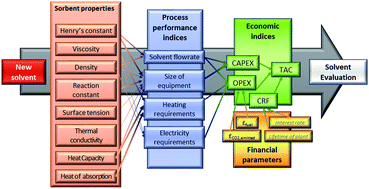当前位置:
X-MOL 学术
›
Sustain. Energy Fuels
›
论文详情
Our official English website, www.x-mol.net, welcomes your feedback! (Note: you will need to create a separate account there.)
Solvent selection and design for CO2 capture – how we might have been missing the point
Sustainable Energy & Fuels ( IF 5.6 ) Pub Date : 2017-11-01 00:00:00 , DOI: 10.1039/c7se00404d Maria T. Mota-Martinez 1, 2, 3, 4, 5 , Jason P. Hallett 1, 2, 3, 4 , Niall Mac Dowell 2, 3, 4, 5, 6
Sustainable Energy & Fuels ( IF 5.6 ) Pub Date : 2017-11-01 00:00:00 , DOI: 10.1039/c7se00404d Maria T. Mota-Martinez 1, 2, 3, 4, 5 , Jason P. Hallett 1, 2, 3, 4 , Niall Mac Dowell 2, 3, 4, 5, 6
Affiliation

|
Carbon capture and storage (CCS) is a vital technology for the cost-effective mitigation of anthropogenic CO2 emissions. However, a key obstacle to its deployment on a large scale remains its cost – both capital and operating costs. In this context, the development of improved sorbents is a key research priority. Consequently, there is a vast global effort to develop new materials for this purpose, with literally thousands of new materials having been proposed since the beginning of the millennium. One common element of these contributions is that they focus on the equilibrium capacity of the material to absorb CO2 and rarely, if ever, other key factors such as transport properties. To date, the majority of this effort has cost significant amounts of time and resources and has almost exclusively focused on developing sorbents with increased CO2 capacity and/or reduced heat of regeneration. Given that sorbent regeneration largely dictates operational cost, this would, on the surface, appear rational. However, it is vital to recall that the cost structure of $ per MWh of electricity generated is composed of contributions from both capital and operational costs. Consequently, this single-minded focus on equilibrium CO2 capacity and heat of regeneration excludes the contribution of transport and kinetic properties which determine the equipment size and thus the capital cost. Therefore, in order to develop sorbents which will result in a non-negligible cost reduction, it is essential to move beyond equilibrium-based metrics of sorbent performance. In this paper, we present a new methodological approach for sorbent screening which explicitly includes rate-based phenomena. Our approach uses both monetised and non-monetised performance indicators. Our results suggest that whilst equilibrium CO2 capacity is a key determinant of process performance, transport properties (e.g., viscosity) and other thermophysical properties (e.g., heat capacity) have a significant effect on the capital cost, and thus on the price of the carbon captured. The key contribution of this work is the identification of the minimum set of thermophysical and kinetic parameters which must be reported in order to justify the claim of adequacy for a new sorbent for CO2 capture in particular and gas separations in general.
中文翻译:

CO 2捕集的溶剂选择和设计–我们可能遗漏了这一点
碳捕集与封存(CCS)是一种经济有效地降低人为CO 2排放的重要技术。但是,大规模部署的主要障碍仍然是成本-资金成本和运营成本。在这种情况下,改进吸附剂的开发是关键的研究重点。因此,全球为此付出了巨大的努力来开发新材料,自从千年开始以来已经提出了数千种新材料。这些贡献的一个共同要素是,它们专注于材料吸收CO 2的平衡能力。并且很少(如果有的话)其他关键因素(例如运输属性)。迄今为止,大部分努力花费了大量时间和资源,并且几乎专门用于开发具有增加的CO 2容量和/或减少的再生热的吸附剂。考虑到吸附剂的再生在很大程度上决定了运营成本,从表面上看,这似乎是合理的。但是,重要的是要记住,每兆瓦时发电的成本结构由资本成本和运营成本构成。因此,这种专心致志地专注于平衡CO 2再生的能力和热量排除了运输和动力学特性的影响,而运输和动力学特性决定了设备的尺寸,进而决定了资本成本。因此,为了开发出可以导致不可忽略的成本降低的吸附剂,必须超越基于平衡的吸附剂性能指标。在本文中,我们提出了一种新的吸附剂筛选方法,该方法明确包含了基于速率的现象。我们的方法同时使用了获利和未获利的绩效指标。我们的结果表明,虽然平衡的CO 2容量是工艺性能,运输性能(例如粘度)和其他热物理性能(例如(热容量)对资本成本有很大影响,因此对捕获的碳的价格也有很大的影响。这项工作的关键贡献是确定了必须报告的最小热物理参数和动力学参数,以证明特别是对于捕获CO 2以及一般而言用于气体分离的新型吸附剂的适当性是合理的。
更新日期:2017-11-01
中文翻译:

CO 2捕集的溶剂选择和设计–我们可能遗漏了这一点
碳捕集与封存(CCS)是一种经济有效地降低人为CO 2排放的重要技术。但是,大规模部署的主要障碍仍然是成本-资金成本和运营成本。在这种情况下,改进吸附剂的开发是关键的研究重点。因此,全球为此付出了巨大的努力来开发新材料,自从千年开始以来已经提出了数千种新材料。这些贡献的一个共同要素是,它们专注于材料吸收CO 2的平衡能力。并且很少(如果有的话)其他关键因素(例如运输属性)。迄今为止,大部分努力花费了大量时间和资源,并且几乎专门用于开发具有增加的CO 2容量和/或减少的再生热的吸附剂。考虑到吸附剂的再生在很大程度上决定了运营成本,从表面上看,这似乎是合理的。但是,重要的是要记住,每兆瓦时发电的成本结构由资本成本和运营成本构成。因此,这种专心致志地专注于平衡CO 2再生的能力和热量排除了运输和动力学特性的影响,而运输和动力学特性决定了设备的尺寸,进而决定了资本成本。因此,为了开发出可以导致不可忽略的成本降低的吸附剂,必须超越基于平衡的吸附剂性能指标。在本文中,我们提出了一种新的吸附剂筛选方法,该方法明确包含了基于速率的现象。我们的方法同时使用了获利和未获利的绩效指标。我们的结果表明,虽然平衡的CO 2容量是工艺性能,运输性能(例如粘度)和其他热物理性能(例如(热容量)对资本成本有很大影响,因此对捕获的碳的价格也有很大的影响。这项工作的关键贡献是确定了必须报告的最小热物理参数和动力学参数,以证明特别是对于捕获CO 2以及一般而言用于气体分离的新型吸附剂的适当性是合理的。


























 京公网安备 11010802027423号
京公网安备 11010802027423号